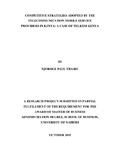| dc.description.abstract | Competitive strategy involves undertaking offensive and defensive moves that
position an organization and enables it to successfully compete in the market. It also
enables an organization to build core and distinctive competencies in response to the
five competitive forces. Telkom Kenya (Orange) has been formulating several
competitive strategies in order to build competitive advantage, increase market share
and consequently profitability. Given the competitive nature of the Kenya
telecommunication industry, the firm has had to continuously monitor their strategies
on the basis of organizational goals as well as in response changes in external and
internal environment. The environment within which Telkom Kenya (Orange)
operates is characterized by fierce competition among existing firms, threat from new
entrants, high bargaining power of consumers, readily available substitute products as
well as relatively high bargaining power of suppliers. The study sought to establish
the competitive strategies that Telkom Kenya (Orange) is adopting to gain
competitive advantage and increase its profits in the long run. Case study research
design was used where primary data was collected from the firm’s top management
while secondary data was collected from published reports and other documents
including company periodicals, economic survey reports and statistical abstracts. The
data collected was qualitative in nature hence content analysis was used by examining
the key words, phrases, sentences and themes that matched the objective of the study.
From the findings, the competitive strategies adopted by Telkom Kenya (Orange) are;
cost Leadership, best cost provider and focused differentiated strategy. Cost
leadership strategy has been achieved by leveraging on existing infrastructure,
infrastructure sharing, tight control of cost and overheads, improving efficiency in
operations, reduction of input costs, tight control of labor costs, use of information
systems and lowering distribution costs. The focused differentiated strategy by TKL is
achieved mostly by offering differentiated products based on their mobile money
platform while best cost provider strategy has been achieved by offering slightly
differentiated products at a cost better than rivals specifically in mobile data. In
addition, other supplementary strategies that TKL has implemented are outsourcing
and strategic alliance. The supplementary strategies have played a key role in
improving the effectiveness of the generic strategies. These strategies have enabled
TKL to compete in the industry, steadily gain market share as well as build brand
loyalty. Based on the findings, cost leadership is the most effective of all strategies
.As much as positive gains have been made, TKL is still faced by many challenges
such as high competition, massive losses, low brand loyalty, rapid technological
change etc. As a result, this study recommends efforts to be made towards increasing
the effectiveness of the other strategies in order to increase market share as well as
strive to be a market leader. Such efforts should be directed towards effectively utilize
its brand, infrastructure, human resource as well as other resource in order to develop
highly differentiated products. Further research is recommended on a comparative
study to be done on the effectiveness of competitive strategies among firm in the
Kenyan telecommunication market where an in-depth study be should done on the
impact of the adopted strategies in order to understand the reason for disparity in
profitability among the existing firms. | en_US |

